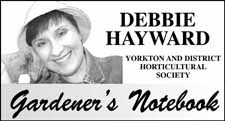First thing, gardeners, I'd like to remind you that the next meeting of the Yorkton and District Horticultural Society will be held on Thursday, April 24 at 7:00 p.m. in the Sunshine Room at SIGN on North Street. Please note the change in dates! Our special guest will be Karen Leis from Runnymede speaking to us about vermiculture and composting with worms.
Make a cup of tea and sit with me for a few minutes. Last time we chatted, I was telling you about a great book that I borrowed from the library: it was called "Maximizing Your Mini Farm: Self-Sufficiecy on ¼ Acre" by Brett L. Markham. The books talks about a wide variety of vegetables, but one section focuses on greens. It is now officially spring, the days are longer, and goodness, it has to warm up sometime! So one of the first spring crops that we can plant are greens. Whether we plant a couple rows in the garden, or a sprinkling of lettuce seeds in a flowerpot by the back door, many greens like the cooler temperatures of spring.
Don't let the term "greens" automatically restrict you only to lettuce. There are many choices such as spinach, arugula, cress, corn salad, mesclun mixes, and of course, many interesting varieties of lettuce. Greens are chock full of vitamins, especially if you grow them yourself and bring them from the plant to the plate in just a matter of minutes.
Leafy greens need nitrogen to do well, so you might want to give them a little boost with some fertilizer. Some very dear friends, who are also excellent gardeners, were telling us just the other day about the great results they got from using alfalfa pellets: a really good choice because they are natural and won't burn our plants.
In his book, Mr. Markham tells us that we can harvest our greens at two stages: early in the spring when the leaves are very small and tender, and can be eaten raw; and then later in the season when the leaves get bigger and more sturdy and are best used cooked. He suggests planting the seeds very close together in the spring, then as we use the plants for fresh harvests early in the season, we gradually make room between plants for the remaining plants to mature and grow larger for our "second harvest" later in the summer.
Leaving the book behind for a moment, on a cooking program we watched recently, the chef had stackable "gardens" that he planted in plastic crates beind his restaurant. He had a wide variety of greens planted, and was harvesting them when they were very young: the leaves were perhaps the size of toonies, maybe slightly larger. Each day he took out a basket and a small pair of scissors and "harvested" his crop. I'll tell you that this was a high-end restaurant, and one of the main attractions was the fact that he grew these organic greens himself. So we should consider ourselves very lucky to be able to enjoy these tasty treats!
As I chat with you today, it's the first time in all our many visits together that I have not had the company of our beloved dog, Toby. Toby was my constant companion when I wrote to you, laying on his pet bed beside our desk. I would often bounce ideas to him as he lay there watching me, and if he raised his eyebrows and stirred from his relaxed sprawl, I knew that I was on to something good! Toby was an avid gardener himself, always with us in the garden, especially loving to lay down right on top of my favorite hostas! Our Toby died last week. He was a loving, faithful, gentle, sweet, and always amusing dog; a beloved family member; and a precious little soul that we will love forever. A special plant will be planted in our garden this spring in his memory.
Have a good week!



